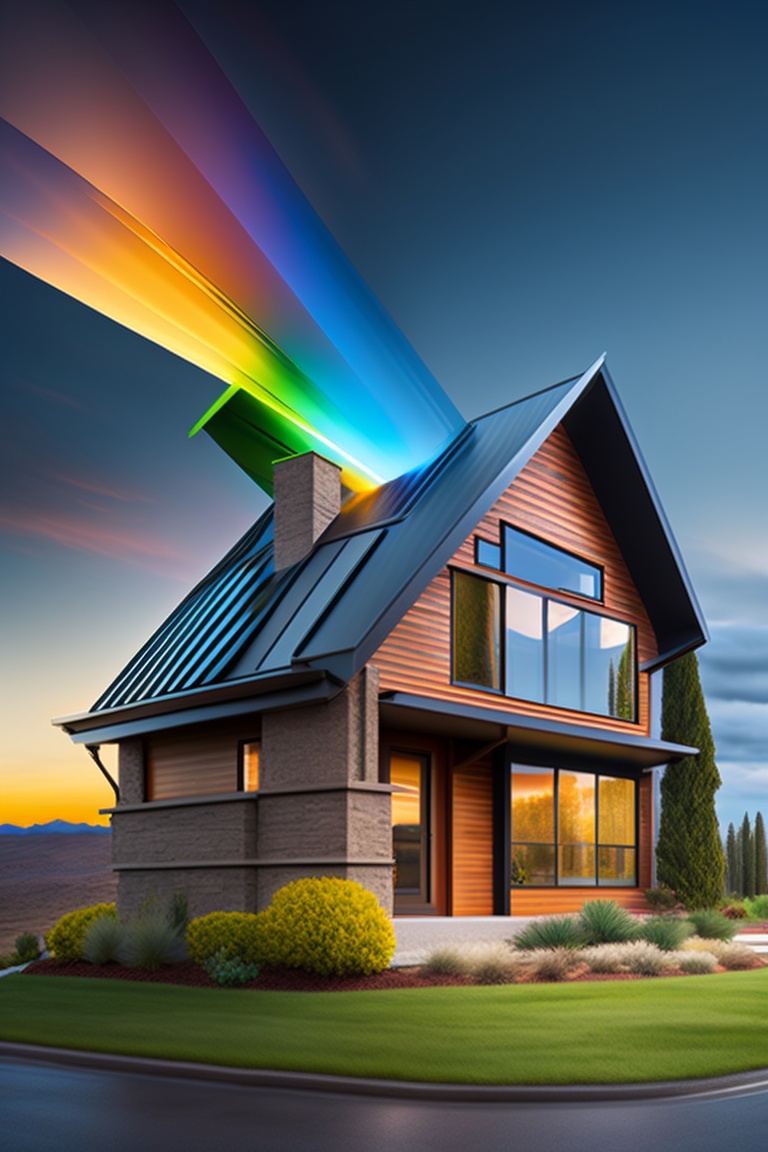Energy Efficient Homes: Introduction
Why Energy Efficiency Matters
Energy efficiency is like getting more bang for your buck. It’s using less energy to perform the same task, stretching that energy dollar to its maximum potential. Think of it as the low-carb diet of the energy world. It keeps your home’s energy consumption slim and trim while maintaining the same level of comfort and productivity. This concept matters for a couple of big reasons. First, there’s the immediate, personal impact: saving you some cold hard cash. Less energy usage means lower utility bills. Second, it has broader implications. As we’ll dive into later, energy efficient homes play a crucial role in combating climate change.
What Are Energy Efficient Homes?
Energy-efficient homes are like bodybuilders – they’re built to perform. They’re specifically designed or modified to consume less energy, optimize energy use, and promote a healthier, more comfortable living environment. It’s a home that ‘sweats’ less energy and ‘pumps’ more efficiency—kind of like a house hitting the gym, without sweatbands and dumbbells, of course!
These homes come with insulation that’s a bit like a thick winter coat, windows that reflect rather than absorb heat, and appliances that consume less energy. They’re like an endurance athlete, using every bit of energy to its fullest extent.
The History of Energy Efficient Homes
Understanding the past can shed light on the trajectory of energy-efficient homes and what the future may hold. While the technology we now associate with energy efficiency is relatively modern, the underlying principles can be traced back thousands of years.
Ancient Foundations: Solar Passive Design
Long before the term “energy efficiency” was coined, ancient civilizations were intuitively employing passive solar design. Ancient Greek houses, for example, were often situated to maximize exposure to the winter sun, absorbing heat during the day and releasing it at night. Likewise, Roman villas employed similar designs, sometimes even utilizing early forms of glass windows to trap heat. These practices showcase that the concept of using natural resources wisely is not new; it’s as old as human civilization itself.
The Wake-Up Call: The 1970s Oil Crisis
The oil crisis of the 1970s served as a wake-up call for the modern world. With oil prices skyrocketing, energy became a focal point of innovation and regulatory oversight. This period led to the development of the first energy-efficiency standards, notably affecting appliances and cars. In essence, this crisis transformed energy efficiency from an ancient practice into a modern science.
The Rise of Modern Energy-Efficient Homes: The 1990s Onward
Fast forward to the 1990s, and energy-efficient homes started to look more like what we’re familiar with today. Advanced insulation materials, double and triple-pane windows, and energy-saving appliances became more widespread. It was during this decade that the U.S. Environmental Protection Agency and the Department of Energy launched the Energy Star program in 1992, providing a standardized benchmark for energy-efficient products. This program not only helped consumers make informed choices but also pushed manufacturers to meet higher energy-saving standards.
Mainstream Adoption and Policy Support
As we moved into the 21st century, energy-efficient homes became more than just a specialty; they began to enter the mainstream. Governments around the world started to offer incentives for energy-efficient upgrades, such as tax credits for installing solar panels or replacing old appliances. Additionally, building codes increasingly incorporated energy-efficient standards, further driving the adoption of sustainable practices in home construction.
Digital Age: Smart Homes and IoT
The rise of smart home technology and the Internet of Things (IoT) has ushered in a new era for energy-efficient homes. Automated systems can now control lighting, heating, and cooling, optimizing energy use based on real-time data. Even refrigerators and washing machines have joined the party, with features designed to minimize energy and water consumption.
In conclusion, the journey of energy-efficient homes from ancient passive solar designs to modern, tech-savvy sanctuaries shows a fascinating evolution. What started as instinctual practices to harness the sun’s energy has become a sophisticated field, combining architecture, engineering, and cutting-edge technology. And as we continue to face global environmental challenges, the role of energy-efficient homes in a sustainable future becomes ever more critical.
The Advantages of Energy Efficient Homes
Economic Benefits
The most immediate advantage of having an energy-efficient home is the impact on your wallet. It’s like having a personal financial trainer, trimming the fat off your monthly utility bills. According to Energy Star, a U.S. Environmental Protection Agency voluntary program, energy-efficient homes can save homeowners up to 30% on energy bills. Yes, that’s a chunk of change you can use for something else you love, like adding to your sneaker collection or funding your travel bug.
Environmental Benefits
An energy-efficient home is a responsible citizen of Planet Earth. By reducing its energy usage, it cuts down on carbon emissions, combating climate change. It’s a step towards reducing our overall carbon footprint. By investing in an energy-efficient home, you’re not just saving money, but also contributing to a healthier, greener world.
Increased Comfort and Wellbeing
An often-overlooked benefit of energy-efficient homes is the increase in comfort and well-being. Because these homes are well-insulated and designed to optimize natural light, they maintain more consistent temperatures and better air quality. It’s like living in a temperature-regulated cocoon, free from outside temperature swings and drafty corners.
Energy Efficient Homes Around the Globe
Countries around the world are stepping up their efforts to address climate change by promoting energy-efficient homes and buildings. These efforts are helping to reduce emissions, save money, and create more sustainable communities.
Germany
Germany is often cited as a trailblazer when it comes to energy-efficient housing. The country is well-known for its “Passivhaus” or “Passive House” standard, a voluntary benchmark that dramatically reduces a building’s energy requirements and ecological footprint. Buildings meeting this standard require little active heating or cooling, achieving savings through superior insulation, airtight construction, and advanced window technology. With over 25,000 buildings constructed to meet these rigorous standards, Germany demonstrates how energy efficiency can be both effective and widely adopted. Their example serves as an inspiration for countries and communities around the globe.
Sweden
Sweden is not to be left behind in the race toward greater energy efficiency. The country has set an ambitious target: to achieve net-zero emissions of greenhouse gases by 2045. A significant part of this plan involves enhancing the energy efficiency of homes and other buildings. Swedish construction companies are adopting the use of energy-efficient materials and incorporating renewable energy sources, like solar and wind power, into their designs. Moreover, the country is investing in research to explore innovative green energy solutions and technologies, making energy efficiency a cornerstone of their long-term sustainability plan.
Japan
Japan has its unique set of challenges when it comes to energy efficiency, primarily due to its lack of abundant natural resources. However, this has only spurred the nation to become more innovative. The Japanese “Smart Cities” initiative showcases a commitment to advanced energy-saving technologies. These cities incorporate a range of approaches from smart grids that optimize energy distribution to energy-efficient appliances and cutting-edge solar panel technology. Japan’s focus on energy efficiency extends to residential buildings, where there’s a push for homes to be not just energy-efficient but also more sustainable through the use of recyclable materials.
Australia
Australia is another country taking steps towards improving the energy efficiency of its homes and buildings. With its varying climates, Australia faces a unique set of challenges, prompting a diverse range of solutions. Programs like the Nationwide House Energy Rating Scheme (NatHERS) aim to improve building designs to make them more energy-efficient. This initiative rates homes based on their thermal performance, encouraging better-insulated and better-designed homes that require less energy for heating and cooling.
Canada
Canada, with its cold winters and varied geography, places particular importance on energy-efficient housing. Federal and provincial programs offer incentives for homeowners to retrofit their homes with energy-saving features like improved insulation, high-efficiency boilers, and smart thermostats. Some provinces have even mandated that new residential buildings meet specific energy efficiency criteria, showcasing a strong governmental push towards sustainability.
Each of these countries provides valuable insights into the future of energy-efficient homes, contributing to a growing global trend. From Germany’s highly effective Passivhaus standard to Japan’s tech-savvy Smart Cities, different approaches are proving that energy-efficient living is not just a possibility but a reality that benefits both our planet and our pocketbooks.
Components of Energy Efficient Homes
Insulation
Think of insulation as your home’s snug winter coat. Just like that puffy jacket keeps you warm in winter by trapping your body heat, good insulation keeps your home warm by preventing heat from escaping. In the summer, it works in reverse—keeping the heat out and cool air in. Essentially, insulation stops your heating and cooling system from working harder than it needs to, kind of like a personal trainer for your HVAC system.
Energy Efficient Appliances
Your appliances need to get with the program too! Energy-efficient appliances are the superheroes of your household, doing the same work but using less energy. They’re like the nerds of appliances—smart, efficient, and always there when you need them. And they come in all shapes and sizes, from refrigerators and dishwashers to light bulbs and water heaters.
Renewable Energy Sources
Here’s where it gets really exciting—powering your home with renewable energy. It’s like giving your home a renewable energy superhero cape! Solar panels, wind turbines, and geothermal systems let you generate your own energy, often saving you significant money over the long run. They’re the Captain Planets of home energy, harnessing the power of the wind, sun, and earth to provide your home with clean, green energy.
Making Your Home More Energy Efficient
Insulation Tips and Tricks
So how can you beef up your home’s insulation? There are several ways to get the job done. Start with sealing drafts in your home. Drafts are like tiny thieves, stealing the warm or cool air from your home and replacing it with outdoor air. You can also add extra insulation to your attic, walls, and floors. And don’t forget to insulate those ducts and pipes!
Choosing the Right Appliances
When it comes to appliances, look for the Energy Star label. These appliances are certified to be more energy-efficient than their conventional counterparts. They may cost a bit more upfront, but the savings you’ll realize in your monthly utility bills will more than make up for the initial cost over time. Think of it as an investment that pays dividends!
Incorporating Renewable Energy
Incorporating renewable energy into your home might sound like something straight out of a sci-fi movie, but it’s a very real and increasingly common way to boost your home’s energy efficiency. Whether you’re installing solar panels, wind turbines, or geothermal systems, these upgrades can drastically reduce your home’s reliance on traditional, non-renewable energy sources.
Tracking Your Progress
A crucial step in the journey to a more energy-efficient home is tracking your progress. It’s like stepping on the scale after a few weeks of a new diet—you need to know if your efforts are paying off. Luckily, several tools and apps allow you to track your home’s energy usage, showing you where you’re making progress and where there’s room for improvement.
The Future of Energy Efficient Homes
The road to a more sustainable future is paved with innovations that promise to make our homes not just efficient, but practically autonomous in managing energy consumption. Let’s hop into our imaginary time machine and see what the future holds for energy-efficient homes.
Predicted Advances
Smart Home Technology Meets AI
The integration of smart home technology and artificial intelligence (AI) in energy-efficient homes is less of a dream and more of an inevitability. Imagine an AI-powered “virtual butler” that learns your behavior and daily routines. This AI system could intelligently adjust heating and cooling systems, lighting, and even your smart refrigerator to minimize energy waste. It’ll schedule tasks and appliances to operate at times when electricity costs are lowest, automatically aiding in both energy and financial savings.
Renewable Energy Integration
The trend towards harnessing renewable energy sources like solar, wind, and geothermal energy will accelerate. Your home could essentially become a mini power station, capable of generating, storing, and even selling back surplus energy to the grid. This isn’t just energy efficiency; it’s energy independence.
Far-fetched Possibilities
Self-Repairing Homes
In a future where nanotechnology has reached its peak, the concept of self-repairing homes may not seem so far-fetched. Imagine walls, floors, and even electrical circuits imbued with nanobots that can detect issues and repair them on the spot, much like how our body heals a cut or bruise. This would not only save on repair costs but would also improve energy efficiency by promptly fixing any energy leaks or gaps in insulation.
Adaptive “Smart Skin” Homes
Hold onto your hats because things are about to get sci-fi-level amazing. Imagine a home that can adapt its exterior to weather conditions. Using advanced materials, the outer layer of your home—its “smart skin”—could dynamically change its properties. On a sweltering summer day, it could become highly reflective, bouncing back the sun’s heat. On a cold winter night, it could capture and store heat, ensuring that your living spaces stay cozy without overtaxing your heating system.
The Zero-Waste Home
Think beyond energy efficiency to a zero-waste lifestyle. Future homes could be designed with recycling and composting systems built into the architecture. An integrated waste management system could sort and process your waste, even repurposing it in creative ways. For example, food waste could be automatically composted and used to nourish your garden.
While some of these ideas may seem like the stuff of science fiction, remember that many technologies we take for granted today were once deemed fantastical. In the realm of energy-efficient homes, the sky—or perhaps even the stars—are the limit.
Conclusion
There’s a quiet revolution brewing, and it’s called energy efficiency. The concept is pretty straightforward – get the most out of your energy usage while causing the least impact on the environment. It’s like eco-friendly productivity, only for your home.
Energy efficient homes are the superstars in this revolution. They’re the homes that go the extra mile, ensuring that every watt of energy is used judiciously. These homes are the frontrunners in the race to a greener, more sustainable world.
Adopting energy efficiency might sound like a daunting task, especially if you’re starting from scratch. But remember, even the smallest steps can have a significant impact. The road to an energy-efficient home starts with awareness and understanding, which you now have. After all, we’ve journeyed together through the what, why, and how of energy efficient homes.
Going forward, we will witness new innovations in this sphere, from the emergence of AI-powered smart homes to the exciting potential of renewable energy sources. The future is bright (and efficient), my friends!
In the realms of far-fetched fantasies, we might even see self-repairing or weather-adapting homes. But let’s remember that today’s reality is yesterday’s fantasy. Who knows what tomorrow may bring?
So, how about joining this revolution? An energy-efficient home is not just an investment in your wallet or property value; it’s an investment in the future of our planet. It’s a statement that says, “Yes, I care about the world I live in, and I’m doing my part to protect it.”
FAQs
What are the benefits of an energy-efficient home?
Besides saving money on utility bills and contributing to a healthier planet, energy-efficient homes are typically more comfortable to live in. They have fewer drafts, more consistent temperatures, and better air quality.
What are some ways to make my home more energy-efficient?
There are many ways to make your home more energy-efficient. Start by sealing drafts, adding insulation, using LED lights, and choosing Energy Star appliances. Then consider bigger steps like installing renewable energy systems.
Is it expensive to make my home energy-efficient?
The cost varies depending on what you’re doing. Some steps, like sealing drafts and changing light bulbs, are relatively inexpensive. Others, like adding insulation or installing solar panels, are more of an investment. However, these costs are often offset by the money you’ll save on your utility bills over time.
How does insulation contribute to energy efficiency?
Insulation works by reducing the amount of heat that escapes from your home in the winter and enters your home in the summer. This means your heating and cooling system has to work less, which saves energy.
What is renewable energy and how can it help make my home more energy-efficient?
Renewable energy comes from sources that naturally replenish, like the sun, wind, and earth. By using renewable energy systems like solar panels or wind turbines, you can generate your own electricity and reduce your reliance on the power grid.




